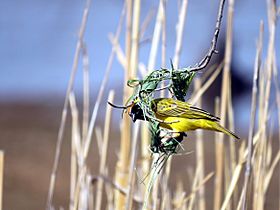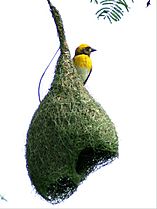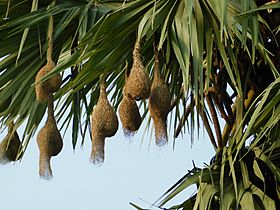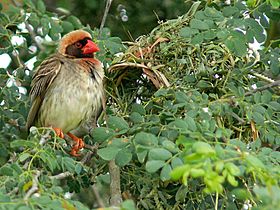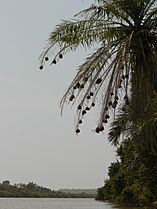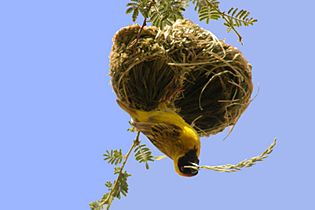Weavers facts for kids
Quick facts for kids Weavers |
|
|---|---|
 |
|
| A male village weaver (Ploceus cucullatus bohndorffi), building his nest | |
| Scientific classification |
|
| Kingdom: | Animalia |
| Phylum: | Chordata |
| Class: | Aves |
| Order: | Passeriformes |
| Superfamily: | Passeroidea |
| Family: | Ploceidae Sundevall, 1836 |
| Genera | |
|
See text. |
|
Weavers are a family of small passerine birds, also known as weaverbirds or weaver finches. They get their name because they build amazing nests by weaving together plants. These birds are mostly found in Africa south of the Sahara Desert. Some also live in tropical parts of Asia. A few types of weavers have been brought to other parts of the world.
Contents
What Are Weavers?
The scientific name for the weaver family is Ploceidae. This group includes many birds known for their special nest-building skills. The family was first named by a Swedish scientist, Carl Sundevall, in 1836. Weavers are not closely related to common sparrows.
Types of Weavers
The weaver family is split into different groups. These include buffalo weavers, sparrow weavers, typical weavers, and widow weavers. Each group has its own unique features. You can see a list of some of the main types below.
| Image | Genus | Species |
|---|---|---|
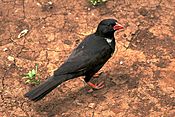 |
Bubalornis A. Smith, 1836 |
|
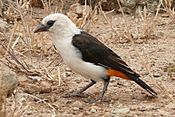 |
Dinemellia Reichenbach, 1863 |
|
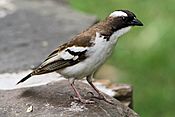 |
Plocepasser A. Smith, 1836 |
|
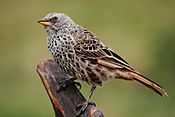 |
Histurgops Reichenow, 1887 |
|
 |
Pseudonigrita Reichenow, 1903 |
|
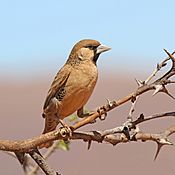 |
Philetairus A. Smith, 1837 |
|
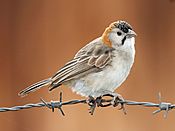 |
Sporopipes Cabanis, 1847 |
|
 |
Amblyospiza Carl Jakob Sundevall, 1850 |
|
 |
Ploceus Cuvier, 1816 |
|
 |
Malimbus Vieillot, 1805 |
|
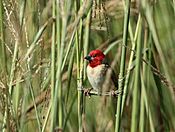 |
Quelea L. Reichenbach, 1850 |
|
 |
Anaplectes L. Reichenbach, 1863 |
|
 |
Foudia L. Reichenbach, 1850 |
|
| Brachycope Reichenow, 1900 |
|
|
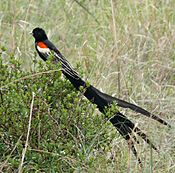 |
Euplectes Swainson, 1829 |
|
Appearance and Habitat
Many male weavers are very colorful. They often have bright red or yellow feathers mixed with black. Some species only show these bright colors during the breeding season. Weavers eat seeds and have strong, cone-shaped beaks. You can often find weaverbird groups living near water.
Weaver Behavior and Nest Building
Weavers are famous for their amazing nests. They weave together plant materials like thin leaf fibers, grass, and twigs. The nests can be different sizes and shapes, depending on the type of weaver.
- Intricate Nests: Many weavers create very fine, woven nests. These nests often have narrow entrances that point downwards, making them safe from predators.
- Large Colony Nests: Some weavers, like the buffalo-weavers, build huge, messy stick nests. Inside these big nests, they make smaller, round woven nests for their families.
- Apartment-Style Nests: The sociable weavers in Africa build giant "apartment-house" nests. These huge structures can house 100 to 300 pairs of birds! Each pair has its own flask-shaped room with an entrance tube at the bottom.
- Cooperative Breeding: Sparrow weavers live in family groups and work together to raise their young.
Most weaver species like to live in large groups. They often build their nests close together on the same tree branch. This helps protect them from danger. Usually, the male birds build the nests. They use their nest-building skills to impress female birds and find a mate.
Weavers and People
Sometimes, large groups of weavers can cause problems for farmers. For example, the red-billed quelea is thought to be the most common bird in the world. When many of them gather, they can eat a lot of crops.
Images for kids
-
Plocepasser nest in Namibia, for year-round occupation.
-
Communal Philetairus nests in central Namibia
-
Pseudonigrita nest in Kenya, with entrance below
-
Black-breasted weaver nest suspended from grass, India
-
A baya weaver on his unfinished nest, northern India
-
Male Quelea at nest concealed in thorny Senegalia shrub
-
Red bishop constructing a nest in reeds, South Africa
-
Nests of a colony of Sakalava weavers, Madagascar
-
Spherical village weaver nests suspended from a palm tree, West Africa
-
A southern masked weaver building his nest, Namibia
See also
 In Spanish: Weaver para niños
In Spanish: Weaver para niños


